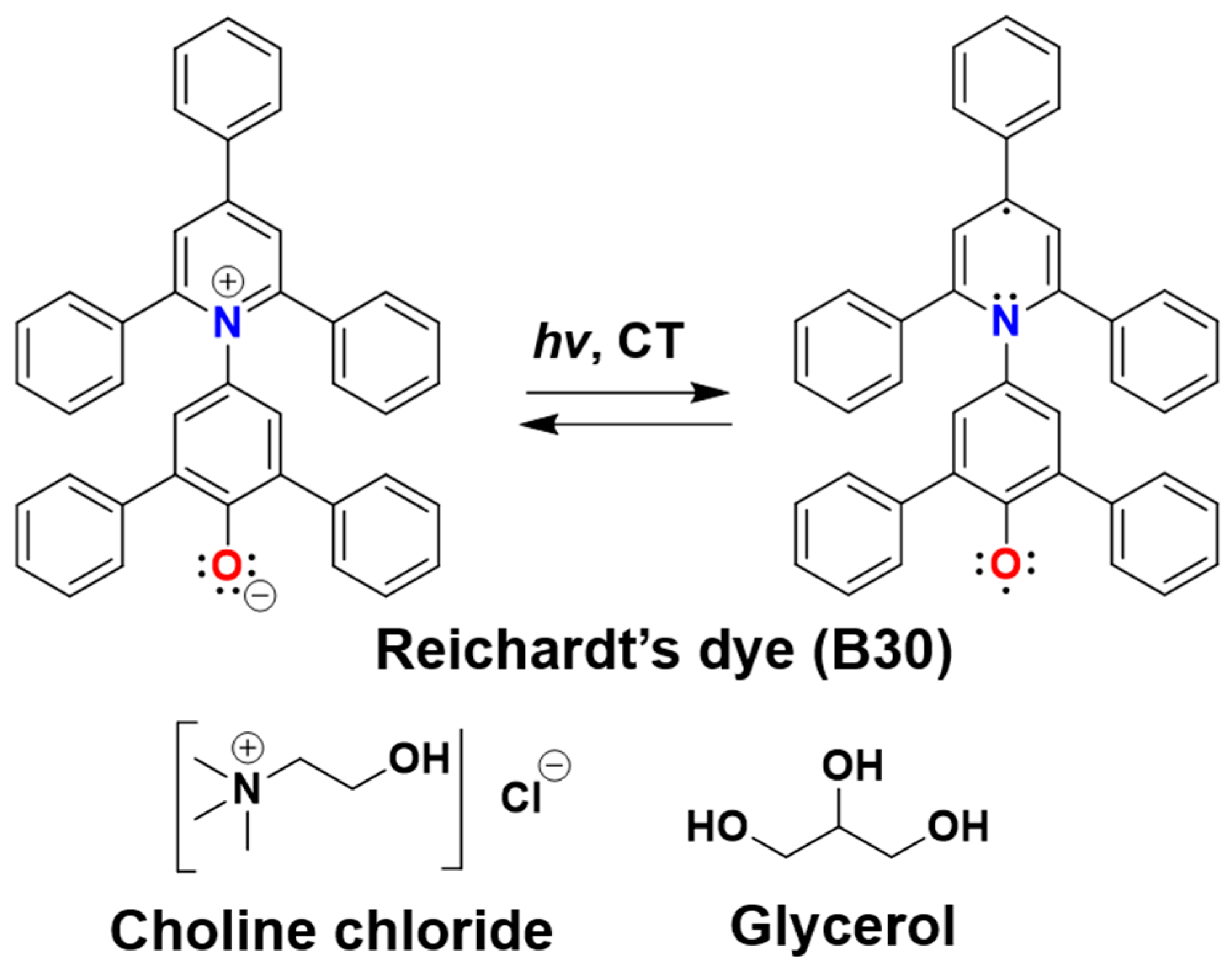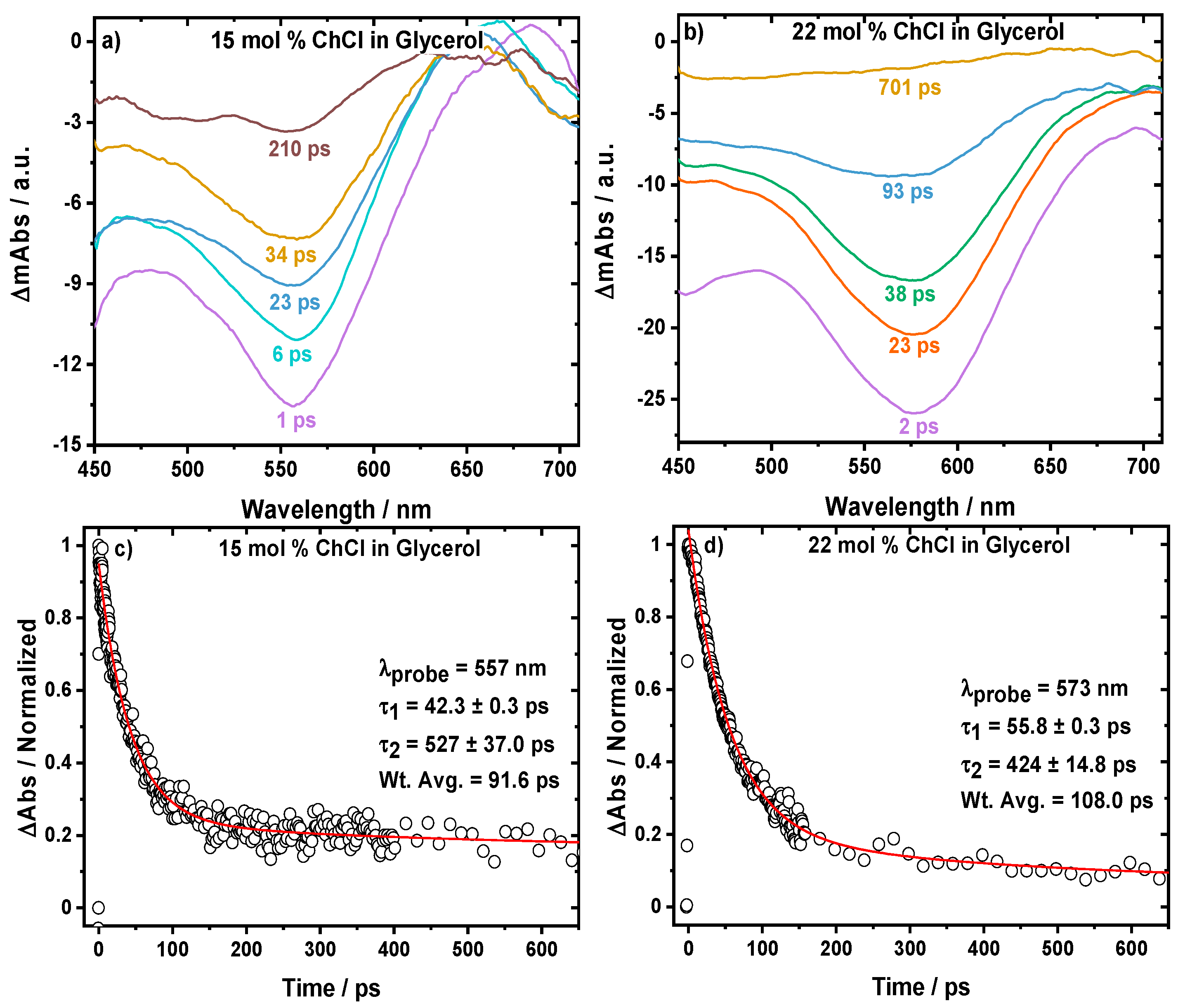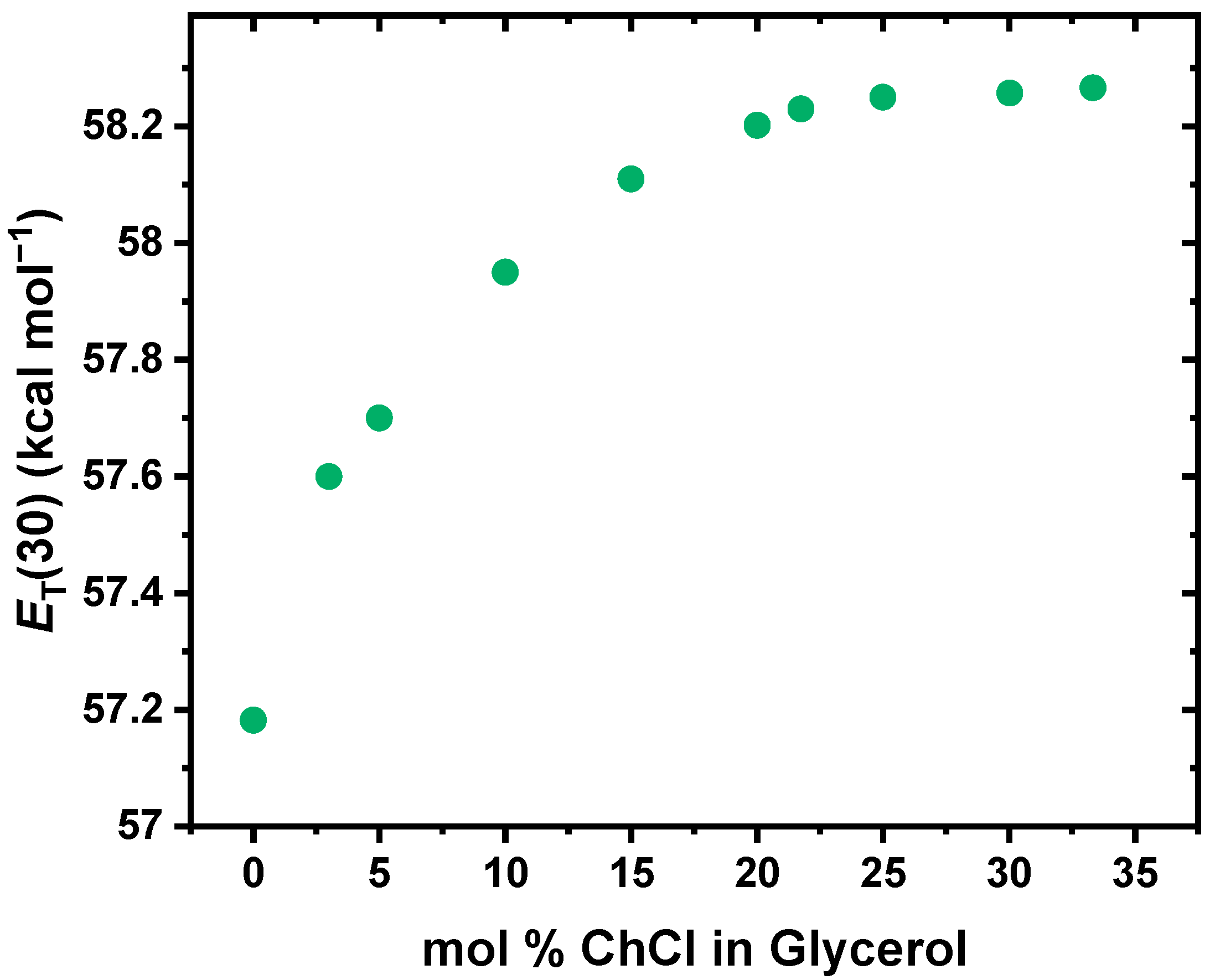Insights from Femtosecond Transient Absorption Spectroscopy into the Structure–Function Relationship of Glyceline Deep Eutectic Solvents
Abstract
:1. Introduction
2. Results
2.1. Solvent Relaxation Dynamics
2.2. Viscosity, Ionic Conductivity, and Density Measurements
2.3. Solvent Polarity
3. Discussion
4. Materials and Methods
4.1. Materials
4.2. Preparation of Solvent Mixtures
4.3. Measurements of Relaxation Dynamics and Solvent Polarity
4.4. Measurements of Viscosity and Density
4.5. Measurements of Ionic Conductivity
5. Conclusions
Supplementary Materials
Author Contributions
Funding
Institutional Review Board Statement
Informed Consent Statement
Data Availability Statement
Conflicts of Interest
References
- Pigłowska, M.; Kurc, B.; Galiński, M.; Fuć, P.; Kamińska, M.; Szymlet, N.; Daszkiewicz, P. Challenges for safe electrolytes applied in lithium-ion cells—A review. Materials 2021, 14, 6783. [Google Scholar] [CrossRef] [PubMed]
- Weber, A.Z.; Mench, M.M.; Meyers, J.P.; Ross, P.N.; Gostick, J.T.; Liu, Q. Redox flow batteries: A review. J. Appl. Electrochem. 2011, 41, 1137–1164. [Google Scholar] [CrossRef]
- Alotto, P.; Guarnieri, M.; Moro, F. Redox flow batteries for the storage of renewable energy: A review. Renew. Sustain. Energy Rev. 2014, 29, 325–335. [Google Scholar] [CrossRef]
- Mohamed, M.R.; Sharkh, S.M.; Walsh, F.C. Redox flow batteries for hybrid electric vehicles: Progress and challenges. In Proceedings of the 2009 IEEE Vehicle Power and Propulsion Conference, Dearborn, MI, USA, 7–11 September 2009; pp. 551–557. [Google Scholar] [CrossRef]
- Tang, L.; Leung, P.; Xu, Q.; Mohamed, M.R.; Dai, S.; Zhu, X.; Flox, C.; Shah, A.A. Future perspective on redox flow batteries: Aqueous versus nonaqueous electrolytes. Curr. Opin. Chem. Eng. 2022, 37, 100833. [Google Scholar] [CrossRef]
- Abbott, A.P.; Boothby, D.; Capper, G.; Davies, D.L.; Rasheed, R.K. Deep Eutectic Solvents formed between choline chloride and carboxylic acids: Versatile alternatives to ionic liquids. J. Am. Chem. Soc. 2004, 126, 9142–9147. [Google Scholar] [CrossRef] [PubMed]
- Abbott, A.P.; Capper, G.; Davies, D.L.; Rasheed, R.K.; Tambyrajah, V. Novel solvent properties of choline chloride/urea mixtures. Chem. Commun. 2003, 70–71. [Google Scholar] [CrossRef] [PubMed]
- García, G.; Aparicio, S.; Ullah, R.; Atilhan, M. Deep eutectic solvents: Physicochemical properties and gas separation applications. Energy Fuels 2015, 29, 2616–2644. [Google Scholar] [CrossRef]
- Zhang, Q.; De Oliveira Vigier, K.; Royer, S.; Jérôme, F. Deep eutectic solvents: Syntheses, properties and applications. Chem. Soc. Rev. 2012, 41, 7108–7146. [Google Scholar] [CrossRef] [PubMed]
- Wu, J.; Liang, Q.; Yu, X.; Qiu-Feng, L.; Ma, L.; Qin, X.; Chen, G.; Li, B. Deep Eutectic Solvents for Boosting Electrochemical Energy Storage and Conversion: A Review and Perspective. Adv. Funct. Mater. 2021, 31, 2011102. [Google Scholar] [CrossRef]
- Hansen, B.B.; Spittle, S.; Chen, B.; Poe, D.; Zhang, Y.; Klein, J.M.; Horton, A.; Adhikari, L.; Zelovich, T.; Doherty, B.W.; et al. Deep Eutectic Solvents: A Review of Fundamentals and Applications. Chem. Rev. 2021, 121, 1232–1285. [Google Scholar] [CrossRef]
- Ijardar, S.P.; Singh, V.; Gardas, R.L. Revisiting the Physicochemical Properties and Applications of Deep Eutectic Solvents. Molecules 2022, 27, 1368. [Google Scholar] [CrossRef] [PubMed]
- Miller, M.A.; Wainright, J.S.; Savinell, R.F. Communication—Iron Ionic Liquid Electrolytes for Redox Flow Battery Applications. J. Electrochem. Soc. 2016, 163, A578–A579. [Google Scholar] [CrossRef]
- Smith, E.L.; Abbott, A.P.; Ryder, K.S. Deep Eutectic Solvents (DESs) and Their Applications. Chem. Rev. 2014, 114, 11060–11082. [Google Scholar] [CrossRef]
- Abbott, A.P.; Cullis, P.M.; Gibson, M.J.; Harris, R.C.; Raven, E. Extraction of glycerol from biodiesel into a eutectic based ionic liquid. Green Chem. 2007, 9, 868–872. [Google Scholar] [CrossRef]
- Abbott, A.P.; Harris, R.C.; Ryder, K.S.; D’Agostino, C.; Gladden, L.F.; Mantle, M.D. Glycerol eutectics as sustainable solvent systems. Green Chem. 2011, 13, 82–90. [Google Scholar] [CrossRef]
- Spittle, S.; Poe, D.; Doherty, B.; Kolodziej, C.; Heroux, L.; Haque, M.A.; Squire, H.; Cosby, T.; Zhang, Y.; Fraenza, C.; et al. Evolution of microscopic heterogeneity and dynamics in choline chloride-based deep eutectic solvents. Nat. Commun. 2022, 13, 219. [Google Scholar] [CrossRef] [PubMed]
- Zhang, Y.; Poe, D.; Heroux, L.; Squire, H.; Doherty, B.W.; Long, Z.; Dadmun, M.; Gurkan, B.; Tuckerman, M.E.; Maginn, E.J. Liquid Structure and Transport Properties of the Deep Eutectic Solvent Ethaline. J. Phys. Chem. B 2020, 124, 5251–5264. [Google Scholar] [CrossRef] [PubMed]
- Kalhor, P.; Xu, J.; Ashraf, H.; Cao, B.; Yu, Z.-W. Structural Properties and Hydrogen-Bonding Interactions in Binary Mixtures Containing a Deep-Eutectic Solvent and Acetonitrile. J. Phys. Chem. B 2020, 124, 1229–1239. [Google Scholar] [CrossRef]
- Kumari, P.; Shobhna; Kaur, S.; Kashyap, H.K. Influence of Hydration on the Structure of Reline Deep Eutectic Solvent: A Molecular Dynamics Study. ACS Omega 2018, 3, 15246–15255. [Google Scholar] [CrossRef]
- Azmi, S.; Koudahi, M.F.; Frackowiak, E. Reline deep eutectic solvent as a green electrolyte for electrochemical energy storage applications. Energy Environ. Sci. 2022, 15, 1156–1171. [Google Scholar] [CrossRef]
- Yadav, A.; Kar, J.R.; Verma, M.; Naqvi, S.; Pandey, S. Densities of aqueous mixtures of (choline chloride + ethylene glycol) and (choline chloride + malonic acid) deep eutectic solvents in temperature range 283.15–363.15 K. Thermochim. Acta 2015, 600, 95–101. [Google Scholar] [CrossRef]
- Celebi, A.T.; Vlugt, T.J.H.; Moultos, O.A. Structural, Thermodynamic, and Transport Properties of Aqueous Reline and Ethaline Solutions from Molecular Dynamics Simulations. J. Phys. Chem. B 2019, 123, 11014–11025. [Google Scholar] [CrossRef]
- LaRocca, M.M.; Baker, G.A.; Heitz, M.P. Assessing rotation and solvation dynamics in ethaline deep eutectic solvent and its solutions with methanol. J. Chem. Phys. 2021, 155, 034505. [Google Scholar] [CrossRef] [PubMed]
- Wang, Y.; Ma, C.; Liu, C.; Lu, X.; Feng, X.; Ji, X. Thermodynamic Study of Choline Chloride-Based Deep Eutectic Solvents with Water and Methanol. J. Chem. Eng. Data 2020, 65, 2446–2457. [Google Scholar] [CrossRef]
- Alfurayj, I.; Fraenza, C.C.; Zhang, Y.; Pandian, R.; Spittle, S.; Hansen, B.; Dean, W.; Gurkan, B.; Savinell, R.; Greenbaum, S.; et al. Solvation Dynamics of Wet Ethaline: Water is the Magic Component. J. Phys. Chem. B 2021, 125, 8888–8901. [Google Scholar] [CrossRef] [PubMed]
- Alfurayj, I.; Fraenza, C.C.; Pandian, R.; Greenbaum, S.; Burda, C. Solvation dynamics of choline fluoride in ethylene glycol—Water mixtures. J. Mol. Liq. 2023, 392, 123448. [Google Scholar] [CrossRef]
- Baz, J.; Held, C.; Pleiss, J.; Hansen, N. Thermophysical properties of glyceline–water mixtures investigated by molecular modelling. Phys. Chem. Chem. Phys. 2019, 21, 6467–6476. [Google Scholar] [CrossRef] [PubMed]
- Prado, D.M.; Shen, X.; Savinell, R.; Burda, C. Hydrodynamic voltammetry of Fe2+/3+ in aqueous deep eutectic solvents towards redox flow batteries. Electrochim. Acta 2023, 467, 143082. [Google Scholar] [CrossRef]
- Alfurayj, I.; Prado, D.M.; Prado, R.C.; Samia, A.C.; Burda, C. Unusual Hydration Properties of Choline Fluoride-Based Deep Eutectic Solvents. J. Phys. Chem. B 2024, 128, 2762–2772. [Google Scholar] [CrossRef] [PubMed]
- Aravena, P.; Cea-Klapp, E.; Gajardo-Parra, N.F.; Held, C.; Garrido, J.M.; Canales, R.I. Effect of water and hydrogen bond acceptor on the density and viscosity of glycol-based eutectic solvents. J. Mol. Liq. 2023, 389, 122856. [Google Scholar] [CrossRef]
- Gajardo-Parra, N.F.; Lubben, M.J.; Winnert, J.M.; Leiva, Á.; Brennecke, J.F.; Canales, R.I. Physicochemical properties of choline chloride-based deep eutectic solvents and excess properties of their pseudo-binary mixtures with 1-butanol. J. Chem. Thermodyn. 2019, 133, 272–284. [Google Scholar] [CrossRef]
- Alfurayj, I.; Pandian, R.; Springer, S.; Burda, C. Choline Fluoride-Ethylene glycol deep eutectic solvent mixture—Synthesis and physicochemical properties. J. Mol. Liq. 2023, 386, 122454. [Google Scholar] [CrossRef]
- Migliorati, V.; D’Angelo, P. Deep eutectic solvents: A structural point of view on the role of the anion. Chem. Phys. Lett. 2021, 777, 138702. [Google Scholar] [CrossRef]
- Hossain, S.S.; Sneha, P.; Samanta, A. Complete Solvation Dynamics of Coumarin 153 in Tetraalkylammonium Bromide-Based Deep Eutectic Solvents. J. Phys. Chem. B 2020, 124, 2473–2481. [Google Scholar] [CrossRef]
- Rahman, M.B.A.; Jumbri, K.; Basri, M.; Abdulmalek, E.; Sirat, K.; Salleh, A.B. Synthesis and physico-chemical properties of new tetraethylammonium-based amino acid chiral ionic liquids. Molecules 2010, 15, 2388–2397. [Google Scholar] [CrossRef] [PubMed]
- Yusof, R.; Abdulmalek, E.; Sirat, K.; Rahman, M.B.A. Tetrabutylammonium bromide (TBABr)-Based deep eutectic solvents (DESs) and their physical properties. Molecules 2014, 19, 8011–8026. [Google Scholar] [CrossRef]
- Pandian, R.; Kim, D.; Zhang, Y.; Alfurayj, I.; Prado, D.M.; Maginn, E.; Burda, C. Chain length and OH-spacing effects on diol-based deep eutectic solvents. J. Mol. Liq. 2024, 393, 123534. [Google Scholar] [CrossRef]
- Xu, L.H.; Wu, D.; Zhong, M.; Wang, G.B.; Chen, X.Y.; Zhang, Z.J. The construction of a new deep eutectic solvents system based on choline chloride and butanediol: The influence of the hydroxyl position of butanediol on the structure of deep eutectic solvent and supercapacitor performance. J. Power Sources 2021, 490, 229365. [Google Scholar] [CrossRef]
- Bachrach, S.M. Microsolvation of 1,4-butanediol: The competition between intra- and intermolecular hydrogen bonding. J. Phys. Chem. A 2014, 118, 1123–1131. [Google Scholar] [CrossRef]
- Cerar, J.; Jamnik, A.; Tomšič, M. Supra-molecular structure and rheological aspects of liquid terminal 1,n-diols from ethylene glycol, 1,3-propandiol, 1,4-butanediol to 1,5-pentanediol. J. Mol. Liq. 2019, 276, 307–317. [Google Scholar] [CrossRef]
- Gajardo-Parra, N.F.; Cotroneo-Figueroa, V.P.; Aravena, P.; Vesovic, V.; Canales, R.I. Viscosity of Choline Chloride-Based Deep Eutectic Solvents: Experiments and Modeling. J. Chem. Eng. Data 2020, 65, 5581–5592. [Google Scholar] [CrossRef]
- Wagle, D.V.; Deakyne, C.A.; Baker, G.A. Quantum Chemical Insight into the Interactions and Thermodynamics Present in Choline Chloride Based Deep Eutectic Solvents. J. Phys. Chem. B 2016, 120, 6739–6746. [Google Scholar] [CrossRef] [PubMed]
- Mjalli, F.S.; Ahmed, O.U. Physical properties and intermolecular interaction of eutectic solvents binary mixtures: Reline and ethaline. Asia-Pac. J. Chem. Eng. 2016, 11, 549–557. [Google Scholar] [CrossRef]
- Pandian, R.; Burda, H.; Alfurayj, I.; Reichardt, C.; Burda, C. 60 Years of Betaine 30—From Solvatochromic Discovery to Future Frontiers. J. Phys. Chem. B 2024, 128, 6990–7001. [Google Scholar] [CrossRef] [PubMed]
- Spittle, S.; Alfurajy, I.; Hansen, B.B.; Glynn, K.; Brackett, W.; Pandian, R.; Burda, C.; Sangoro, J. Enhanced Dynamics and Charge Transport at the Eutectic Point: A New Paradigm for the Use of Deep Eutectic Solvent Systems. JACS Au 2023, 3, 3024–3030. [Google Scholar] [CrossRef] [PubMed]
- Dimroth, K.; Reichardt, C.; Siepmann, T.; Bohlmann, F. Über Pyridinium-N-phenol-betaine und ihre Verwendung zur Charakterisierung der Polarität von Lösungsmitteln. Justus Liebigs Ann. Chem. 1963, 661, 1–37. [Google Scholar] [CrossRef]
- Reid, P.J.; Barbara, P.F. Dynamic Solvent Effect on Betaine-30 Electron-Transfer Kinetics in Alcohols. J. Phys. Chem. 1995, 99, 3554–3565. [Google Scholar] [CrossRef]
- Mente, S.R.; Maroncelli, M. Computer simulations of the solvatochromism of betaine-30. J. Phys. Chem. B 1999, 103, 7704–7719. [Google Scholar] [CrossRef]
- Lobaugh, J.; Rossky, P.J. Solvent and intramolecular effects on the absorption spectrum of betaine-30. J. Phys. Chem. A 2000, 104, 899–907. [Google Scholar] [CrossRef]
- Reichardt, C. Polarity of ionic liquids determined empirically by means of solvatochromic pyridinium N-phenolate betaine dyes. Green Chem. 2005, 7, 339–351. [Google Scholar] [CrossRef]
- Budzák, Š.; Jaunet-Lahary, T.; Laurent, A.D.; Laurence, C.; Medved, M.; Jacquemin, D. Exploring the Solvatochromism of Betaine 30 with Ab Initio Tools: From Accurate Gas-Phase Calculations to Implicit and Explicit Solvation Models. Chem. Eur. J. 2017, 23, 4108–4119. [Google Scholar] [CrossRef]
- Burda, H.; Hsieh, I.; Burda, C.; Parson, W.W. Entropy-Enthalpy Compensation in Electron-Transfer Processes. J. Phys. Chem. Lett. 2024, 15, 3946–3952. [Google Scholar] [CrossRef]
- Reichardt, C. Solvation Effects in Organic Chemistry: A Short Historical Overview. J. Org. Chem. 2022, 87, 1616–1629. [Google Scholar] [CrossRef] [PubMed]
- Reichardt, C. Solvatochromic Dyes as Solvent Polarity Indicators. Chem. Rev. 1994, 94, 2319–2358. [Google Scholar] [CrossRef]
- Beard, M.C.; Turner, G.M.; Schmuttenmaer, C.A. Measuring Intramolecular Charge Transfer via Coherent Generation of THz Radiation. J. Phys. Chem. A 2002, 106, 878–883. [Google Scholar] [CrossRef]
- Turner, A.H.; Holbrey, J.D. Investigation of glycerol hydrogen-bonding networks in choline chloride/glycerol eutectic-forming liquids using neutron diffraction. Phys. Chem. Chem. Phys. 2019, 21, 21782–21789. [Google Scholar] [CrossRef] [PubMed]
- Root, L.J.; Stillinger, F.H. Short-range order in glycerol. A molecular dynamics study. J. Chem. Phys. 1989, 90, 1200–1208. [Google Scholar] [CrossRef]
- Zhuang, W.; Dellago, C. Dissociation of Hydrogen Chloride and Proton Transfer in Liquid Glycerol: An Ab Initio Molecular Dynamics Study. J. Phys. Chem. B 2004, 108, 19647–19656. [Google Scholar] [CrossRef]
- Padró, J.A.; Saiz, L.; Guàrdia, E. Hydrogen bonding in liquid alcohols: A computer simulation study. J. Mol. Struct. 1997, 416, 243–248. [Google Scholar] [CrossRef]
- Towey, J.J.; Soper, A.K.; Dougan, L. The structure of glycerol in the liquid state: A neutron diffraction study. Phys. Chem. Chem. Phys. 2011, 13, 9397–9406. [Google Scholar] [CrossRef] [PubMed]
- Faraone, A.; Wagle, D.V.; Baker, G.A.; Novak, E.C.; Ohl, M.; Reuter, D.; Lunkenheimer, P.; Loidl, A.; Mamontov, E. Glycerol Hydrogen-Bonding Network Dominates Structure and Collective Dynamics in a Deep Eutectic Solvent. J. Phys. Chem. B 2018, 122, 1261–1267. [Google Scholar] [CrossRef] [PubMed]
- Jimenez, R.; Fleming, G.R.; Kumar, P.V.; Maroncelli, M. Femtosecond solvation dynamics of water. Nature 1994, 369, 471–473. [Google Scholar] [CrossRef]
- D’Agostino, C.; Harris, R.C.; Abbott, A.P.; Gladden, L.F.; Mantle, M.D. Molecular motion and ion diffusion in choline chloride based deep eutectic solvents studied by 1H pulsed field gradient NMR spectroscopy. Phys. Chem. Chem. Phys. 2011, 13, 21383–21391. [Google Scholar] [CrossRef] [PubMed]
- Kovalenko, S.A.; Eilers-König, N.; Senyushkina, T.A.; Ernsting, N.P. Charge transfer and solvation of betaine-30 in polar solvents—A femtosecond broadband transient absorption study. J. Phys. Chem. A 2001, 105, 4834–4843. [Google Scholar] [CrossRef]
- Alomar, M.K.; Hayyan, M.; Alsaadi, M.A.; Akib, S.; Hayyan, A.; Hashim, M.A. Glycerol-based deep eutectic solvents: Physical properties. J. Mol. Liq. 2016, 215, 98–103. [Google Scholar] [CrossRef]
- Abbott, A.P. Application of hole theory to the viscosity of ionic and molecular liquids. ChemPhysChem 2004, 5, 1242–1246. [Google Scholar] [CrossRef]
- Reichardt, C. Pyridinium N-phenolate betaine dyes as empirical indicators of solvent polarity: Some new findings. Pure Appl. Chem. 2004, 76, 1903–1919. [Google Scholar] [CrossRef]
- Fraenza, C.C.; Elgammal, R.A.; Garaga, M.N.; Bhattacharyya, S.; Zawodzinski, T.A.; Greenbaum, S.G. Dynamics of Glyceline and Interactions of Constituents: A Multitechnique NMR Study. J. Phys. Chem. B 2022, 126, 890–905. [Google Scholar] [CrossRef] [PubMed]
- Wagle, D.V.; Baker, G.A.; Mamontov, E. Differential Microscopic Mobility of Components within a Deep Eutectic Solvent. J. Phys. Chem. Lett. 2015, 6, 2924–2928. [Google Scholar] [CrossRef]
- Sazali, A.L.; AlMasoud, N.; Amran, S.K.; Alomar, T.S.; Pa’ee, K.F.; El-Bahy, Z.M.; Yong, T.-L.K.; Dailin, D.J.; Chuah, L.F. Physicochemical and thermal characteristics of choline chloride-based deep eutectic solvents. Chemosphere 2023, 338, 139485. [Google Scholar] [CrossRef] [PubMed]
- Nowosielski, B.; Jamrógiewicz, M.; Łuczak, J.; Śmiechowski, M.; Warmińska, D. Experimental and predicted physicochemical properties of monopropanolamine-based deep eutectic solvents. J. Mol. Liq. 2020, 309, 113110. [Google Scholar] [CrossRef]
- Reichardt, C. Empirical Parameters of the Polarity of Solvents. Angew. Chem. Int. Ed. Engl. 1965, 4, 29–40. [Google Scholar] [CrossRef]
- Reichardt, C. Empirische Parameter der Lösungsmittelpolarität. Angew. Chem. 1965, 77, 30–40. [Google Scholar] [CrossRef]
- Åkesson, E.; Walker, G.C.; Barbara, P.F. Dynamic solvent effects on electron transfer rates in the inverted regime: Ultrafast studies on the betaines. J. Chem. Phys. 1991, 95, 4188–4194. [Google Scholar] [CrossRef]






Disclaimer/Publisher’s Note: The statements, opinions and data contained in all publications are solely those of the individual author(s) and contributor(s) and not of MDPI and/or the editor(s). MDPI and/or the editor(s) disclaim responsibility for any injury to people or property resulting from any ideas, methods, instructions or products referred to in the content. |
© 2025 by the authors. Licensee MDPI, Basel, Switzerland. This article is an open access article distributed under the terms and conditions of the Creative Commons Attribution (CC BY) license (https://creativecommons.org/licenses/by/4.0/).
Share and Cite
Pandian, R.; Burda, C. Insights from Femtosecond Transient Absorption Spectroscopy into the Structure–Function Relationship of Glyceline Deep Eutectic Solvents. Molecules 2025, 30, 1059. https://doi.org/10.3390/molecules30051059
Pandian R, Burda C. Insights from Femtosecond Transient Absorption Spectroscopy into the Structure–Function Relationship of Glyceline Deep Eutectic Solvents. Molecules. 2025; 30(5):1059. https://doi.org/10.3390/molecules30051059
Chicago/Turabian StylePandian, Rathiesh, and Clemens Burda. 2025. "Insights from Femtosecond Transient Absorption Spectroscopy into the Structure–Function Relationship of Glyceline Deep Eutectic Solvents" Molecules 30, no. 5: 1059. https://doi.org/10.3390/molecules30051059
APA StylePandian, R., & Burda, C. (2025). Insights from Femtosecond Transient Absorption Spectroscopy into the Structure–Function Relationship of Glyceline Deep Eutectic Solvents. Molecules, 30(5), 1059. https://doi.org/10.3390/molecules30051059





